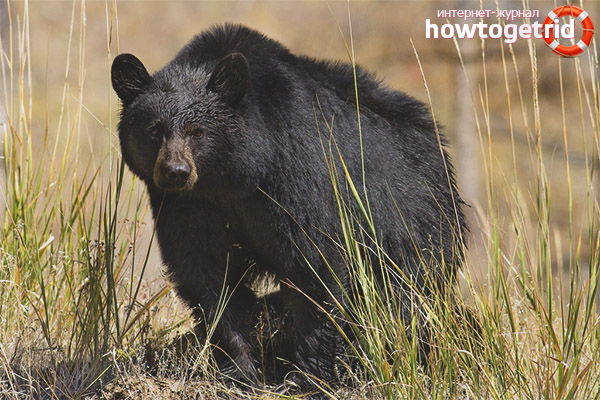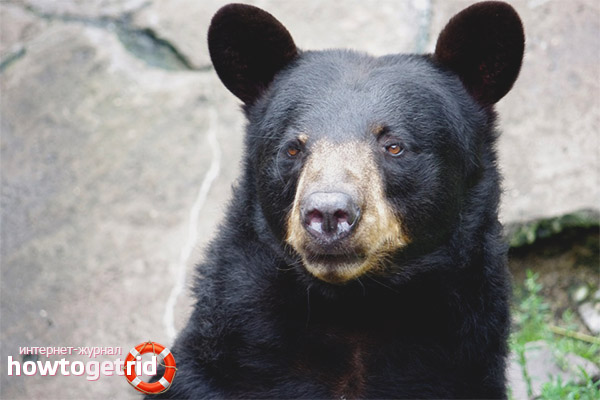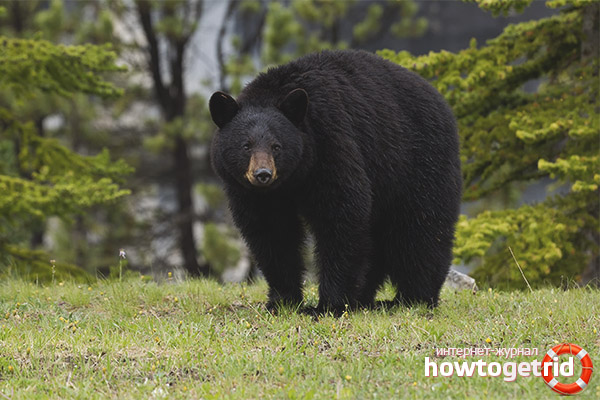The content of the article
The variety of amazing wildlife did not pass by the well-known to everyone bears. The hero of favorite fairy tales and cartoons by both children and adults is often remembered in two of his images, which correlate with existing forms in reality. So, “Umka” presented knowledge of white bears living in the North; “Masha and the Bear” is about brown people who have chosen a temperate climatic zone. However, the Bear family is not limited to these representatives, which is confirmed by the baribals, otherwise called black bears.
These mammals, like other bears, are predators. There is a disagreement among the classifiers, since some researchers isolate the baribals, referring to a separate genus with the Latin name Euarstos. Also called North American, black bears are grouped into sixteen subspecies groups. One of these are, for example, glacial bears.
What do individuals look like?
Original in baribals, without a doubt, is the color of the fur. That is why, first of all, they differ from the brown ones in black. The second distinctive feature of the species is its size, since baribals are smaller than the large-sized brown heroes of Russian folk tales. Adult males grow up to two meters in length. The weight of the largest of the identified males was equal to 363 kilograms. Female baribals are smaller in size: they reach a meter and a half in length, weigh less than 250 kilograms. The average height of the bear is one meter. The tail of animals in size does not exceed 15 centimeters. The completion of the "portrait in height" of the black bear will be the emphasis on the particular sharpness of the shape of the muzzle, as well as on its long limbs and short feet.
As noted above, the color of baribal is black. The muzzle and chest of the bear are sometimes distinguished by fur dyed with lighter shades. Rare are carriers of fur skins of a different color among representatives of this species of the bear family. At the same time, cubs of both brown and black colors are often found in one litter.
Interesting fact! Some young individuals of baribals have a unique gray color, which is subsequently replaced with a darker fur. This happens around the second year of the animal's life.
Truly beautiful fur is gifted with black baribals with a blue tint. They are also called "blue" or "glacial".
What is the lifestyle of a mammal?
Interesting fact! In territories where food sources are concentrated, groups of bears can settle. This leads to the emergence of a special hierarchy between neighboring individuals.
The good mental abilities of the bears contribute to the curiosity expressed in individuals. The consequence of this is intelligence skills. In addition to this, researchers note that adult baribals are well versed in space. The skill of animal navigation is of great interest for a deeper study.
How long do bears live?

In the natural habitat, the life span of baribals is equivalent to three decades.However, in the current situation of a sharp deterioration of the environmental situation and the development of poaching, the life of a black bear lasts about ten years. About nine out of ten individuals die when they turn two years old, as a result of fishing, shooting, as well as the impact of other technogenic and anthropogenic factors (traffic accidents).
Where are the bears settled?
The main territory of the distribution of the black bear population is North America, which gave one of the unofficial names to the species. Plains and forests became favorable places for the resettlement of individuals. By the end of the 19th century, the population of the continent consisted of two million individuals. But later most of it was destroyed by man. This provoked the departure of representatives of the species of many states and reduced the number of baribals living in the country.
A feature of baribals is the resettlement of each subspecies in specific areas. For example, bears of the species Ursu saméricanus californiensis live on the mountains near California, on the shores of the Pacific Ocean - Ursu saméricanusalti frontalis, in Alaska - Ursus Américan simmons. Today, baribals settle and live in territories densely planted with larch trees and located far from human settlements. On the North American continent, baribals are adjacent to the grizzly known to many, which are a species of brown bears. Most rocky areas are occupied last, which is why black bears are rare there.
What does a bear eat?
In their manner of behavior, bears are distinguished by the absence of aggression and timidity. Another feature of baribals is their omnivorousness. The lack of legibility and finicky made the diet of mammals quite diverse. So, they can taste insects, and berries, and roots. Do not forget that the bear is a predatory animal, but in most cases, eating vertebrates does not occur as a result of targeted hunting, but because of the detection of carrion or carrion. Thus, to the started list of “dishes” it is worth adding treats in the form of small animals: birds, rodents, rabbits and even deer.
An individual of a baribal eats as much as it can accommodate itself. After eating, the bear sleeps. Awakened and hungry, he again begins to search for food. Usually, the animal gives its preference to mountain ash, cranberries, various nuts, blueberries, lingonberries, and, of course, raspberries. The specific content of the plant portion of the baribal diet, comprising from 80 to 90% of all food, varies in accordance with the season, that is, varies from seasonality. In the spring months of April and May, they eat a large number of herbaceous plants growing in the forest during this period. By the beginning of summer, the diet is significantly enriched, since insects are included in it: caterpillars, ants. Autumn is the most favorite bear time. Forests are filled with their favorite delicacy - berries, mushrooms and acorns. The baribals living near the shore of reservoirs also catch fish that rise to spawn in the shallow water zone.
At the same time, autumn is one of the most difficult periods for a bear, since it is in the autumn months that it becomes clear with what “edible baggage” he will go to winter. During this period, the baribal begins not only to be saturated, but to put off fat. This process is of particular importance for females, since during the winter months they will feed the offspring that have appeared. Of course, this critical time is experienced by bears, and they all go into hibernation with a good fat reserve, which various fruits, nuts and acorns, enriched with proteins, fats and carbohydrates, help them to gain.
Enemies of the Baribals
The main enemies of the baribals found in the natural habitat are grizzlies, puma wolves.Interesting is the following pattern, tracked by scientists. A reduction in the number of grizzly populations in a particular territory is followed by an increase in the number of baribals. Particularly dangerous are the little cubs, which become the prey of coyotes. Bears living on the Mississippi coast fall into the jaws of large-sized alligators.
Interesting fact! According to observations made by zoologists, baribals of a unique light color are more dexterous and successful fishermen than black bears. This fact is explained by the ability granted to unusual individuals not to contrast with the sky, but to shade it with their fur color.
Features of procreation
The beginning of summer is marked by the mating season of the baribals. It continues until mid-July. Females and males are looking for a pair with which they mate. For the first time this happens in individuals who have reached the age of three, due to the ability of females to bear children. Female individuals carry offspring within 7-8 months. As a result, cubs are born, the number of which varies from one to three. They are born blind and deaf, the body weight of babies reaches about 300 grams. The first time the cubs open their eyes after four weeks. After that, their growth and development is significantly accelerated. This is due to breast milk, which has a large amount of nutrients. Eating milk of a bear will continue for six months. However, the courtship of the mother does not end there, as the cubs remain with her for up to one and a half years.
The unique ability of baribal cubs is the ability to follow the mother bear after she leaves the winter den. The ongoing interaction allows kids to get acquainted with the basic rules of preserving their own life, as well as the peculiarities of feeding future offspring. If the cub behaves disobediently, the bear can growl at it or even slap it. Excellent nutrition, an active lifestyle contribute to the collection of cubs by eight months of weight equal to 7-9 kilograms.
What is the status of baribals?
An important but no less interesting fact! If you meet a baribal, you can not pretend to be dead, as is customary in the case of brown bears. On the contrary, it is necessary to make a lot of noise in order to scare away a timid animal, thereby preserving both its own and its life.
Since the populations of North American black bears have recently declined significantly, protective measures have appeared. Their introduction allowed to increase the number of individuals living in the territory of national parks and nature reserves.
Video: baribal (Ursus americanus)












Submit